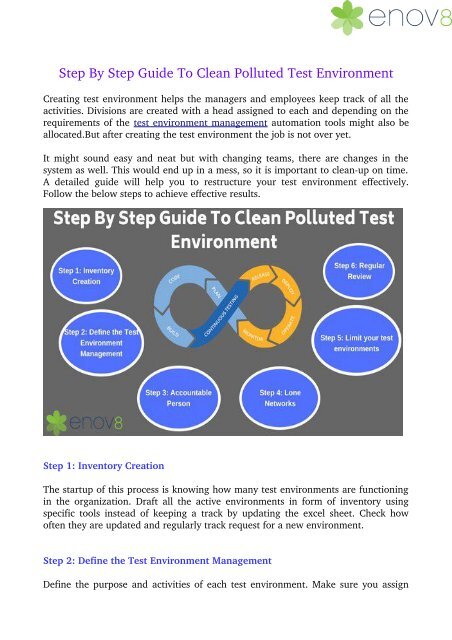Step By Step Guide To Clean Polluted Test Environment
Creating test environment helps the managers and employees keep track of all the activities. A detailed guide will help you to restructure your test environment effectively. Follow the below steps to achieve effective results.
Creating test environment helps the managers and employees keep track of all the activities. A detailed guide will help you to restructure your test environment effectively. Follow the below steps to achieve effective results.
Create successful ePaper yourself
Turn your PDF publications into a flip-book with our unique Google optimized e-Paper software.
<strong>Step</strong> <strong>By</strong> <strong>Step</strong> <strong>Guide</strong> <strong>To</strong> <strong>Clean</strong> <strong>Polluted</strong> <strong>Test</strong> <strong>Environment</strong><br />
Creating test environment helps the managers and employees keep track of all the<br />
activities. Divisions are created with a head assigned to each and depending on the<br />
requirements of the test environment management automation tools might also be<br />
allocated.But after creating the test environment the job is not over yet.<br />
It might sound easy and neat but with changing teams, there are changes in the<br />
system as well. This would end up in a mess, so it is important to cleanup on time.<br />
A detailed guide will help you to restructure your test environment effectively.<br />
Follow the below steps to achieve effective results.<br />
<strong>Step</strong> 1: Inventory Creation<br />
The startup of this process is knowing how many test environments are functioning<br />
in the organization. Draft all the active environments in form of inventory using<br />
specific tools instead of keeping a track by updating the excel sheet. Check how<br />
often they are updated and regularly track request for a new environment.<br />
<strong>Step</strong> 2: Define the <strong>Test</strong> <strong>Environment</strong> Management<br />
Define the purpose and activities of each test environment. Make sure you assign
tasks depending on capabilities of each team. Different organizations have different<br />
requirements thus communicating with the team helps resolve such small issues.<br />
<strong>Step</strong> 3: Accountable Person<br />
Each environment needs one person who takes full responsibility for one particular<br />
test environment. All the reports and progress of that environment will be<br />
communicated to that one person who has been assigned the responsibility.<br />
<strong>Step</strong> 4: Lone Networks<br />
Due to lack of resources and teams, there is a possibility that you might feel the<br />
need of mixing up the environment. But never make the mistake of doing so as this<br />
might end up in losing track of work and you might lose data related to specific<br />
functions.<br />
<strong>Step</strong> 5: Limit your test environments<br />
Make sure that you don't keep adding unnecessary test environments as this would<br />
add up the cost of the organization. In case any request comes up, at first analyze<br />
the worth and if not necessary, reject the request. Having too many test<br />
environments can also create management problem.<br />
<strong>Step</strong> 6: Regular Review<br />
Keep track and gather followups of the activities. Establish weekly reports and<br />
conduct meetings for reviewing any mistakes happening. The best precaution is<br />
attention, if you are aware of what is happening in the process then everything can<br />
be kept under control.<br />
# Contact Us #<br />
Company Name : Enov8<br />
Contact Person : Niall Crawford<br />
Address : Level 5, 14 Martin Place, Sydney, 2000,<br />
New South Wales, Australia.<br />
Phone(s) : +61 2 8916 6391<br />
Website : https://www.enov8.com


















